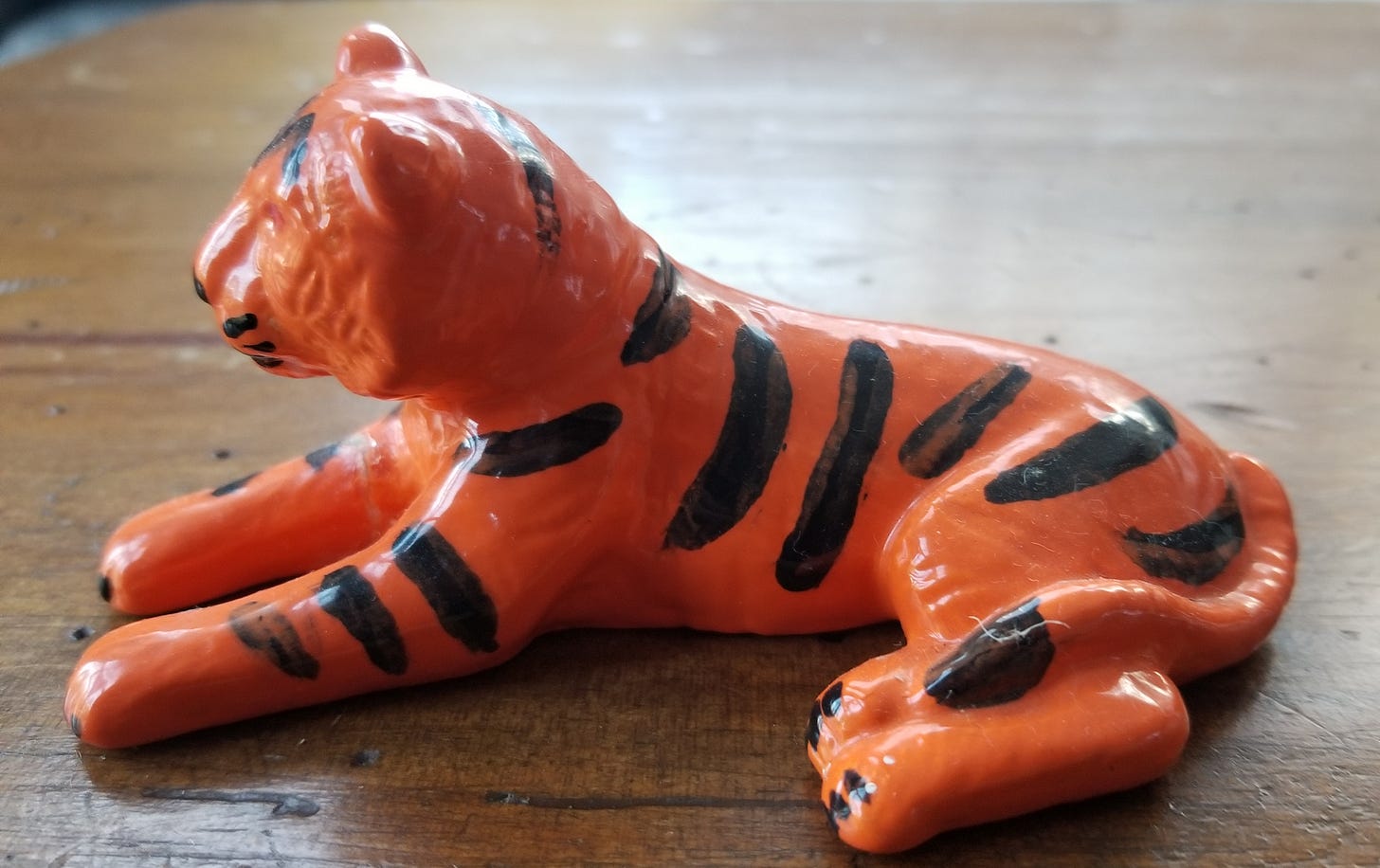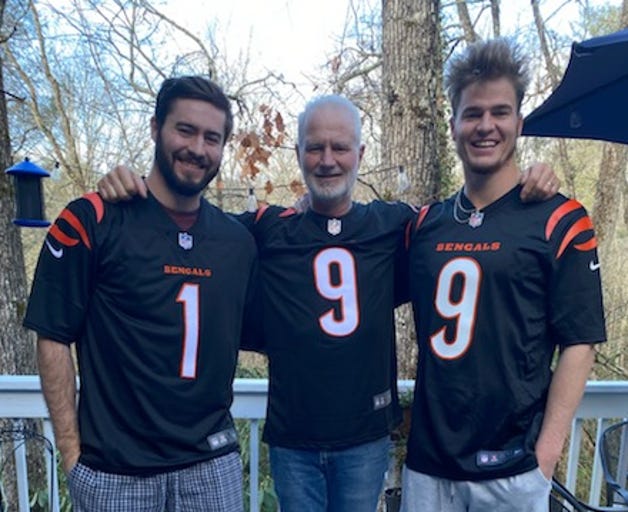Backing the Bengals AND the "Bungles": A Personal History of Loving an Unloved Team
Loyal fans of the Cincinnati Bengals have seen decades of losing and big-game disappointments. Could that change at next week's Super Bowl?
The Cincinnati Bengals’ playoff win over the Kansas City Chiefs last week got me thinking back to the first time these teams met — the first time, in fact, the Bengals met anybody.
I looked it up. Preseason, Aug. 3, 1968. I was in the crowd of 21,682 at University of Cincinnati’s Nippert Stadium, the Bengals’ original, temporary home. As I remember it, just about everybody else there was a middle-aged man smoking a cigar or cigarette — a dense bluish cloud floated high into the lights — which makes me think that not too many of us are still around.
Recently renovated, Nippert is now considered a community treasure and even then seemed pretty impressive to 8-year-old me. But my father saw it for what it was.
“One day,” he told me, “you’ll be able to say you saw these guys play in a little rinky-dink place that seated about 30,000.”
Which is what I’m doing now, so I can brag about my long-standing and only slightly flawed love of the Super Bowl-bound Bengals, which for most of their history have been one of the least-loved, least-successful teams in the National Football League.
In 2011, ESPN Magazine named the Bengals the worst team in all of professional sports, which is all the more remarkable because by then they had a modern stadium and a capable head coach. If it’s possible to be worse than “worst,” that’s what the “Bungles” were in the 1990s, when they embarked on a 14-season streak without a winning record.
Even during this millennium’s sputtering, half-hearted renaissance, the Bengals amassed the NFL’s longest run without a playoff win — 31 years — thanks to a gruesome injury (2006), boneheaded penalties (2016), and the inevitable wilting of the most choke-prone quarterback in the NFL (2012, 2013, 2014, 2015). There was “Good Andy” — Dalton, if you must know his last name — and “Bad Andy,” the one who never failed to show up when it counted.
Watch the career highlight package of an all-time great, and you’ll never see a Bengal because, other than an offensive lineman, we’ve never had one. What you will see is players like Earl Campbell and Joe Montana running over or zipping passes by guys in stripes, as if the Bengals’ whole purpose is to be bad so the league’s stars can look that much better.
For most of the last century, sportswriters heaped praise on the loyal, “long-suffering” fans of baseball’s Cubs and Red Sox. But they suffered in big, rich, respected cities, in beautiful, historic “ballparks.”
We suffered in Cincinnati, and for 30 years, in Riverfront Stadium, an unintentional triumph of brutalist architecture and, especially once November rolled around, the centerpiece of the most relentlessly gray downtown this side of the Iron Curtain.
But, of course, professional franchises mean more to cities like Cincinnati. The Bengals were proof we weren’t a total hick town; we were literally in the same league as New York and Los Angeles. And when the team arrived, led by football genius Paul Brown, he and the players took a place at the very top of the town’s upper crust, which I accessed occasionally and mostly by chance.
Brown lived near us for a while and once showed up — silent, unsmiling, accepting other guests’ reverence as his due — to watch a college bowl game and sip bourbon-laced milk punch at a neighbor’s New Years Day open house.
During the 1974 NFL strike, a few players gathered for informal practices at my junior high school’s field, near Brown’s apartment. We saw them not as scabs but as the team’s good guys, and I still remember the kindness of offensive lineman Howard Fest, who took time to show a kid who clearly had no future in the game (me), the right way to catch a pass.
The Bengal’s first-ever draft pick, Bob Johnson — an instant community pillar at age 22 — joined our church, and at family-night suppers we gazed in amazement at the mountains of 1970s potluck grub he heaped on his plates.
But our ordinary family’s real connection to the Bengals came through one extraordinary family member, my mother’s since-deceased brother, William “Bub” Kite. He was the founding partner of a downtown law firm, a World War II Naval officer and a Princeton University football player good enough to garner a headline in a New York newspaper — something along the lines of, according to my mom, “Kite Will Fly High Tonight.”
He gave us the tickets to see that first-ever game and a few years later started an annual tradition of bestowing upon Pop a pair of season passes — glossy, perforated sheets for 40-yard-line seats, each ticket costing a then-astronomical $7.25.
“Make sure to thank your uncle,” my father whispered to me later. “That’s a lot of money.”
I’m sure I did, but over the years I wasn’t grateful enough for those tickets or respectful enough of my uncle. I never considered that his arthritic hips kept him anchored to his seat, never let this stop me from standing and cheering at big plays or from ignoring his grumbling from one row back: “I didn’t see a goddamn thing. I didn’t see a GOD DAMN thing!”
I never thought, in my 20s, that these games were also family gatherings, and that it might not be necessary to collar the beer guy every single time he came around. “Why didn’t you just bring your own keg, Danny?” Uncle Bub once asked me, sarcastically, which I deserved.
I especially regret this because, as much as I loved going to those games, I love the memories of them more, appreciate how they tied me to my team, my hometown, my uncle, my cousins and my beloved, long-dead Pop.
Every game, he indulged me with a statistics-packed official NFL program and an endless supply of stadium bratwursts, and watched fondly as I devoured both. We didn’t do high fives — I’m not sure any fathers and sons did back then — but when quarterback Kenny Anderson lofted deep passes into the arms of speedster Isaac Curtis, we shared a lot of satisfied smiles.
Which leads to one admission: Following the Bengals hasn’t been all selfless dedication. It’s a little-remembered fact that they were actually a solid team for most of their first 20-some years of existence, twice making it to the Super Bowl and once making NFL history, beating the San Diego Chargers for the AFC Championship in 1982’s sub-zero Freezer Bowl.
I also have to admit that my father and I bailed from that game at halftime, partly because my feet were really, really cold, and partly because we looked around to see that our relatives had all scattered for warmer viewpoints. My cousin, Tom Kite, says I’m wrong, that he toughed it out for the whole game. But NBC cameras definitely caught Uncle Bub in Paul Brown’s luxury box, whooping it up with the great man himself.
Another of my failings as a fan: I lived out of town during the 1990s, when the limits of technology made it easy to tune out my dismal team, which I mostly did.
But I never stopped claiming the Bengals as my main sports love, and since the early 2000s I’ve watched every game my satellite or streaming service would allow. I stood with them during their slow crawl back to respectability, which, related or not, was mirrored by Cincinnati itself. It is gray no more, and if I wasn’t lucky enough to live in the mountains, I’d move back in a heartbeat.
Also, and crucially, I passed on to my sons citizenship into the downtrodden Who Dey Nation (long story), which they accepted like natives.
So I think I’m justified to feel redeemed by this year’s team of young players, a couple of whom seem destined to collect career highlights making other teams look inept. They beat regular-season rivals who have long had their number. They have thrived rather than crumbled under pressure. They have ended their playoff drought, winning not just one but three of those high-stakes games.
Even if they don’t win the Super Bowl, I’ll feel grateful to the Bengals and, a few decades late, to my Uncle Bub, who let me see so much of them. It’s been a blast, these last few weeks, watching TV commentators eat their Bengals-hating words, sharing exultant Facebook posts, texts, and even old-fashioned phone calls with my sons, cousins and Cincinnati friends.
But in looking ahead to next week, I’m also looking back. The Bengals lost that first-ever game, 38-10, and even though that’s expected of expansion teams, it set a trend. Every year since they have come up short at some point. Fifty-four years without ever winning it all. I’d say we’re due.




Wonderful article about a wonderful team and lifetime of stories.
Love this story. Thank you Dan. It transcends football.